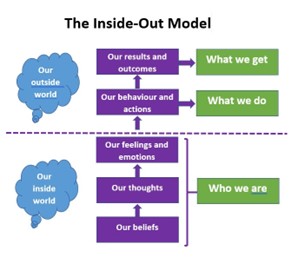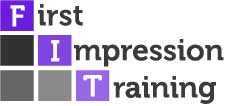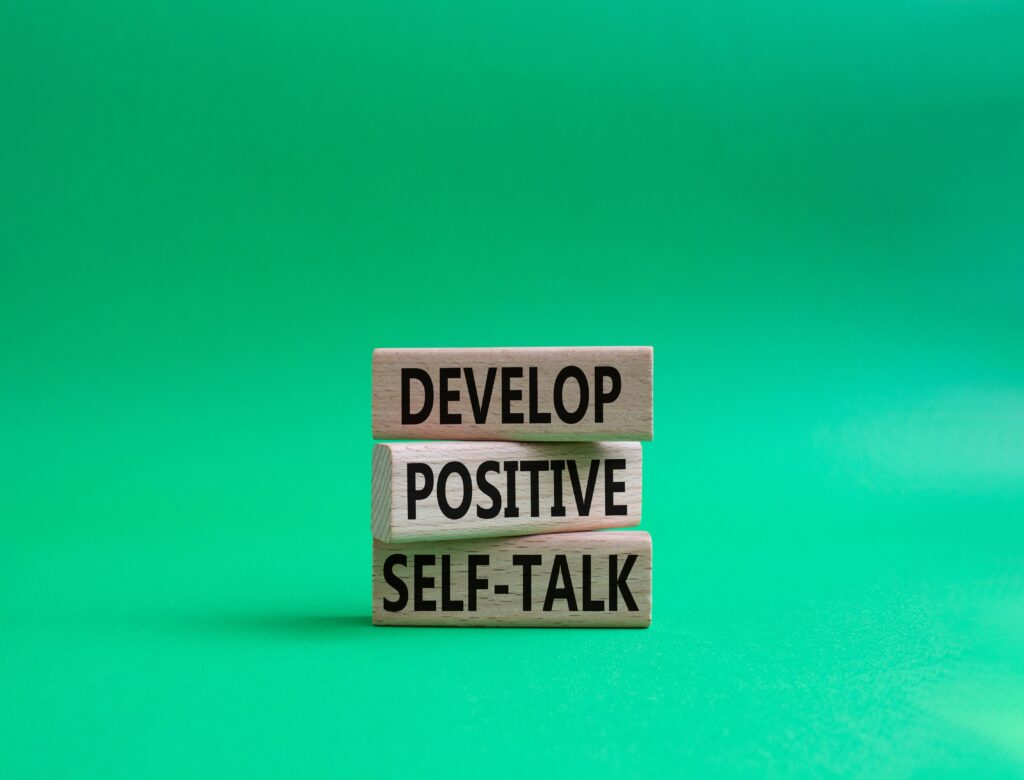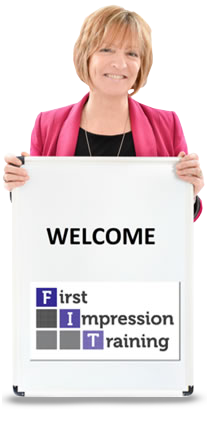According to the National Science Foundation, an average person has around 60,000 thoughts per day, of which 75-95% are repetitive i.e. the majority of the thoughts we had yesterday, are the ones we will have again today – and will have again tomorrow.
Which is a little worrying, given that our thoughts drive our feelings, which drive our behaviour, which impacts our actions, which ultimately affects our results. This would suggest that, if those repetitive thoughts are not serving us i.e. they’re negative, disempowering thoughts, then it’s no wonder we’re not achieving what our heart desires, right?
Omar Itani, writer and creator of the brilliant weekly newsletter The Optimist, spoke about the Power of Thought in a recent article, quoting many of the world’s great historical (and present) thought-leaders, philosophers, and high achievers as having taught us this universal truth:
“As a man thinketh, so he becomes”.
Or put in a more modern way: “we are what we think”.
Positive Self-Talk
It was Earl Nightingale, the grandfather of Positive Thinking who said: “We become what we think about most of the time.”
Our thoughts create our experiences and therefore, we experience what we think. And if we believe that to be true, then it’s the quality of our thoughts that create the quality of our life, agreed?
Well, here’s the kicker….
Also, according to the research, 80% of those 60,000 repetitive thoughts are negative. And we all know how powerful the negative can be, don’t we? If I were to pay you 100 compliments – say 100 lovely things to you or about you, and then say just ONE thing negative to you or about you, what’s the ONE thing you walk away festering on!?
So, if we’re constantly repeating those thoughts AND the vast majority of those thoughts are not serving us well, then the end result is not going to serve us well either.
So, we have to work from the inside-out.

Yet this approach seems counterintuitive, because when we’re unhappy with some aspect of our life, be it our health or wealth or relationships, we begin first by looking for ways to change on the outside. So, we go about transforming our environment, for example, believing that doing so will create the necessary change we’re seeking.
Or maybe we buy things that give us a materialistic boost of positivity or happiness. Or we book a holiday (or go even further and move away completely) in order to escape our problems. Or maybe we seek substances to numb the mind and help us forget all our troubles for the moment. And sometimes, we may retreat entirely, believing that if we go to ground, everything we’re feeling will just magically disappear.
And of course, we end up where we started – unhappy with where we are today and so the cycle repeats itself, where we’re always focusing on the external factors we need to change, in order to create better circumstances &/or more positive outcomes for ourselves.
This repetitive cycle happens because we falsely assume that change begins from the outside. Yet all change happens from the inside-out. Sure, the environment does play a role in changing your circumstances, but it doesn’t address the root cause (your thinking), which is the driver behind why you feel the way you do.
So, if we want to effect change in our external world, then we must start by changing what we’re THINKING in our internal world, because remember – what we think directly influences how we feel, and how we feel directly influences how our body reacts, and how our body reacts directly influences how we behave, and our behaviour or actions directly influence what we get as a result i.e. what we experience in life.
“If you get the inside right, the outside will fall into place”—Eckhart Tolle
It’s important at this stage, to talk about the powerful link between our thoughts, our emotions and our behaviour, because thoughts in and of themselves actually have no power at all, unless or until we actively invest our attention into them. And if we engage with specific thoughts, we begin to feel the emotions that were triggered by these thoughts—we enter a new emotional state, which then influences how we act. Does that make sense?
For example, if you regularly engage with the thought that you’re ‘not good enough’ and you feed attention to that thought, you’ll start to feel down, worthless, discouraged and maybe, even depressed. How does your body react to this? You slump your shoulders, look downwards and project negativity.
Yet, if you engage with more empowering, positive thoughts that would boost your confidence and thus trigger a more positive emotional state, this will then be reflected in how your body reacts – walking tall, standing up straight and appearing upbeat and energised.
This is exactly how your thoughts create your reality.
This means that all the problems we experience are nothing more than a ‘thinking problem’.“If you get the inside right, the outside will fall into place”—Eckhart Tolle
It’s important at this stage, to talk about the powerful link between our thoughts, our emotions and our behaviour, because thoughts in and of themselves actually have no power at all, unless or until we actively invest our attention into them. And if we engage with specific thoughts, we begin to feel the emotions that were triggered by these thoughts—we enter a new emotional state, which then influences how we act. Does that make sense?
For example, if you regularly engage with the thought that you’re ‘not good enough’ and you feed attention to that thought, you’ll start to feel down, worthless, discouraged and maybe, even depressed. How does your body react to this? You slump your shoulders, look downwards and project negativity.
Yet, if you engage with more empowering, positive thoughts that would boost your confidence and thus trigger a more positive emotional state, this will then be reflected in how your body reacts – walking tall, standing up straight and appearing upbeat and energised.
This is exactly how your thoughts create your reality.
This means that all the problems we experience are nothing more than a ‘thinking problem’.
The ‘real problem’ is not the problem.
The ‘real problem’ is how we think about our problem.
We are not our circumstances.
We are what we think of our circumstances.
And that’s exactly why true change begins from the inside, not the outside.
“We spend all our time and money and energy trying to change our experience on the outside, not realizing that the whole thing is being projected from the inside out.” Michael Neill, Best Selling Author of The Inside Out Revolution and Supercoach
So, if you think you’re a failure, you’ll feel like a failure, and then you’ll act like a failure. As long as you give attention to the thought that you’re a failure, you’ll continue to experience this reality, which then reinforces the belief about your reality – that you must be a failure.
This is called a Thought Pattern, which is defined as “a habit of thinking in a particular way.“
In his book, Rewire Your Brain, psychologist John Arden writes: “The more you do something, the more likely it is that you will do it again in the future. Repetition rewires the brain and breeds habits. The more the neurons fire together, the more likely it is that they will fire together in the future.”
Every thought we experience creates a chemical reaction in the brain which then triggers an emotion. As we engage with this thought, it creates a new circuit that sends a signal to the body and we react a certain way. The more we repeat this pattern, the more it seeps into our mind and becomes a habit. This is why neuroscientists quote that “cells that fire together, wire together”
As we repeatedly engage in the same thought patterns, these patterns encode as a blueprint in our subconscious mind – which runs 95% of our life on automatic pilot! As Dr. Bruce Lipton explains: “Neuroscientists have shown that most of our decisions, actions, emotions and behaviour depend on the 95% of brain activity that is beyond our conscious awareness, which means that 95% of our life comes from the programming in our subconscious mind.”
WOW! So, this is why it feels so hard to make change happen!
It’s because we’ve repeated the thought patterns so many times that they’ve now become rooted in who we are. Psychologist Amy Morin explains that “once you draw a conclusion about yourself, you’re likely to do two things – look for evidence that reinforces your belief and discount anything that runs contrary to your belief.”
Your subconscious mind automates your life, which means that, if you’re not aware of your thought patterns, you will continue to live by the same behavioural patterns and therefore, experience the same reality day after day. As the great Carl Jung said: “Until you make the unconscious conscious, it will direct your life and you will call it fate.”
So, what’s the answer?
The answer is in fact, a question!
In order to think differently and thus, create new thought patterns that create a new reality, you need to recondition yourself. However, this isn’t something that you change overnight – this is a lifetime commitment to mindful reprogramming and growth. It’s what neuroscientists refer to as neuroplasticity—the idea that you can rewire your brain, by creating new behavioural patterns where new cells fire together and so, wire together.
And in order for you to do this, you need to understand that you are NOT your thoughts – you are the thoughts you give power and attention to, which means YOU are the THINKER. Remember, your thoughts are nothing more than an endless stream of ideas running through your mind, which are totally powerless until you decide to attach meaning to them, which then trickles into a chain of thought, which creates the Thought Patterns I referred to earlier.
To bring this to life, I want to use the analogy I read about in The Optimist article….
“Imagine your mind to be a farm and your thoughts to be the seeds. You can plant either good seeds (roses) or bad seeds (poison ivy). Whichever seed you choose to focus on and plant, it will then grow and multiply. And the same happens in your mind—whichever thought you choose to focus on and plant, it will then grow and multiply. You are the planter of the seeds because you are the thinker of your thoughts.”
Or maybe you relate more to the native American parable about the wise old Cherokee teaching his grandson about life…
“A fight is going on inside me” he said to the boy. “It is a terrible fight between two wolves. One is evil – he is anger, envy, sorrow, regret, greed, arrogance, self-pity, guilt, resentment, inferiority, lies, false pride, superiority, and ego. The other is good – he is joy, peace, love, hope, serenity, humility, kindness, benevolence, empathy, generosity, truth, compassion, and faith. The same fight is going on inside you and inside every other person, too.” The grandson thought about it for a minute and then asked his grandfather: “which wolf will win?” The old Cherokee simply replied: “The one you feed.”
So, in order to create new Thought Patterns, we need to be more conscious of the thoughts we are giving attention to i.e. which ones we’re feeding – and shift our awareness by observing how these thoughts are causing us to FEEL.
The QUESTION we need to ask, as we catch ourselves in this ‘state of mind’ feeling an unwanted emotion is: “what am I thinking right now? Why am I feeling this way?”
This can help us figure out why we’re feeling what we’re feeling and drive us back to the root cause of these feelings, which of course, are the thoughts we first gave our attention to – this is how your thoughts shape your reality and this is why “you are what you think”
At this point, it’s worth noting that our WORDS are the clothes that our THOUGHTS wear, so we need to dress them well! And THE most important words we will ever speak are the words we speak to ourselves – and we talk to ourselves (oh yes we do!) at a rate of 600 WPM, of which 80% of those words are NEGATIVE, remember?
So, a good next step to start changing those Thought Patterns is to ask another question: “what am I telling myself, by thinking and feeling this way?”
Really lean into the answer – is your self-talk positive and empowering or is it dumbing you down or stifling your brilliance in a negative way?
Only then can you consciously start to change your language (your self-talk), so that the conversations you have with yourself become more optimistic and self-fulfilling. You can check out just how self-sabotaging your self-talk is by completing the self-talk questionnaire here:
And if you’re not satisfied with your answers, well then you now know what you need to do, right!?
If you want to create a new, better or more fulfilling reality then you have to start from within, because personal growth and self-fulfilment is an inside job – and it ALL starts with a THOUGHT!
So, start thinking about your thinking to ensure those thoughts are serving you well and if they’re not, make that conscious effort to change them – right NOW!
Finally, I’d highly recommend Michael Hyatt’s new book “Mind Your Mindset” co-authored with his daughter, Megan Hyatt Miller, which proves the direct relationship between our thoughts and our reality and explains the science behind the fact that ALL success, in both business and life, starts with our thinking.
Those old philosophers were certainly right – we really do become what we think, because we are the sum total of our thoughts. AND our energy flows to where our attentions goes, so we’d better make sure we’re paying attention to the thoughts, feelings and actions that serve us well from now on, agreed!?
Until next time – take care and keep FIT!



















